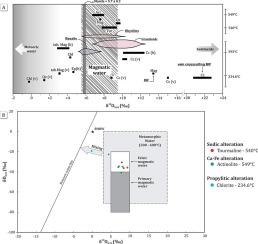当前位置:
X-MOL 学术
›
Ore Geol. Rev.
›
论文详情
Our official English website, www.x-mol.net, welcomes your
feedback! (Note: you will need to create a separate account there.)
A Fluid Inclusion and Stable Isotope (O, H, S and C) study of the Archean IOCG Cristalino deposit, Carajás Mineral Province, Brazil: Implications to ore genesis
Ore Geology Reviews ( IF 3.2 ) Pub Date : 2020-12-01 , DOI: 10.1016/j.oregeorev.2020.103822 Gustavo Souza Craveiro , Raimundo Netuno Nobre Villas , Roberto Perez Xavier
Ore Geology Reviews ( IF 3.2 ) Pub Date : 2020-12-01 , DOI: 10.1016/j.oregeorev.2020.103822 Gustavo Souza Craveiro , Raimundo Netuno Nobre Villas , Roberto Perez Xavier

|
Abstract The hydrothermal history of the Archean Cu-Au Cristalino deposit is recorded in moderately to intensely altered host rocks, which evolved from ~550 °C to ~150 °C. Distal sodic and proximal calcic-ferric, potassic and propylitic alterations developed successively with variable intensity. Two main mineralization types are also recognized: an earlier one characterized by a chalcopyrite + pyrite + magnetite + Au association that occurs as disseminations and breccias in calcic-ferric zones, and a later one represented by a chalcopyrite ± pyrite ± hematite ± Au association that occurs as breccias and veins mainly in potassic and propylitic zones. Estimated pressures (0.6 to 2.6 Kbar) are consonant with brittle and ductile-brittle deformational environments where both alteration and mineralization took place. The ore-bearing fluid was hot (T as high as ~550 °C), acidic and hypersaline (55.1% wt. NaCl equiv.) and chemically approached by the H2O-NaCl-CaCl2-CO2 ± MgCl2 ± FeCl2 system. Salinity might have exceeded 55 wt% NaCl equiv. in the early alteration stages but decreased progressively to 7.9 wt% NaCl equiv. from 250 °C onwards, due to incursion of surficial water into the deposit site. The fluid was initially 18O-enriched and D-depleted (δ18Ov-smow = +9.73 to +6.48‰; δDv-smow = −30.17 to −40.25‰) and most likely derived from magmatic sources. As result of dilution caused by mixing with meteoric water, the fluid became relatively 18O-depleted and D-enriched (δ18Ov-smow = +5.57 to −0.28‰; δDv-smow = −19.15 to −22.24‰). The δ13Cv-pdb values for vein and breccia calcite (−6.5 to −3.8‰) are consistent with a deep source for CO2, likely of mantellic origin. Most δ34Sv-cdt values for chalcopyrite show narrow variation (+1.6 to +3.5‰) and could indicate a homogeneous reservoir for sulfur. However, a few samples reveal significant influence of sedimentary rocks on their isotope composition (δ34Sv-cdt = −32.6‰), showing that sulfur may have been sourced from various reservoirs. It is inferred that most Cu and Au were transported as chloride complexes (>350 °C), and precipitated in response to decrease in temperature and Cl− activity, and increase in pH. The formation of the chalcopyrite ± pyrite ± hematite ± Au association was especially favored by an oxygen fugacity increase during the late stages of the hydrothermal alteration. Secondary fluid inclusions reveal that an aqueous, colder (200–150 °C) and relatively less saline (21–3.1 wt% NaCl equiv.) fluid of uncertain origin circulated in the Cristalino deposit area, which is likely related to a nearby Paleoproterozoic granitic intrusion. In comparison with other Archean Carajas IOCG deposits, particularly those that lie in the southern sector of the Carajas Domain, the Cristalino deposit shows similar structural styles, hydrothermal assemblages, and ore fluid composition and evolution. The data presented here support previous interpretations that consider Cristalino as of IOCG typology.
中文翻译:

巴西卡拉哈斯矿产省太古代 IOCG Cristalino 矿床的流体包裹体和稳定同位素(O、H、S 和 C)研究:对矿石成因的影响
摘要 太古宙 Cu-Au Cristalino 矿床的热液历史记录在中度至强烈蚀变的主岩中,其演化范围为 ~550 °C 至 ~150 °C。远端钠离子和近端钙铁、钾离子和青橄榄石的改变以不同的强度相继发展。还认识到两种主要的矿化类型:早期的一种以黄铜矿 + 黄铁矿 + 磁铁矿 + Au 组合为特征,在钙铁矿带中以散布和角砾岩的形式出现,后期一种以黄铜矿 ± 黄铁矿 ± 赤铁矿 ± Au 组合为代表主要以角砾岩和脉的形式出现在钾质和青岩带中。估计的压力(0.6 到 2.6 Kbar)与发生蚀变和矿化的脆性和韧脆变形环境一致。含矿流体是热的(T 高达 ~550 °C)、酸性和高盐度(55.1% wt. NaCl equiv.),并通过 H2O-NaCl-CaCl2-CO2 ± MgCl2 ± FeCl2 系统进行化学处理。盐度可能已超过 55 wt% NaCl 当量。在早期改变阶段,但逐渐减少到 7.9 wt% NaCl 当量。从 250 °C 开始,由于地表水侵入沉积点。该流体最初富含 18O 且缺乏 D(δ18Ov-smow = +9.73 至 +6.48‰;δDv-smow = -30.17 至 -40.25‰)并且很可能来自岩浆源。由于与大气水混合引起的稀释,流体变得相对缺乏 18O 和富含 D(δ18Ov-smow = +5.57 至 -0.28‰;δDv-smow = -19.15 至 -22.24‰)。脉和角砾岩方解石的 δ13Cv-pdb 值(-6.5 到 -3.8‰)与 CO2 的深源一致,可能起源于地幔。黄铜矿的大多数 δ34Sv-cdt 值显示出窄幅变化(+1.6 至 +3.5‰),并且可能表明硫的均质储层。然而,一些样品揭示了沉积岩对其同位素组成的显着影响(δ34Sv-cdt = -32.6‰),表明硫可能来自不同的储层。据推测,大多数 Cu 和 Au 作为氯化物络合物(> 350 °C)运输,并随着温度和 Cl− 活性的降低以及 pH 值的增加而沉淀。在热液蚀变后期,氧逸度增加尤其有利于黄铜矿 ± 黄铁矿 ± 赤铁矿 ± Au 组合的形成。次生流体包裹体显示含水、较冷(200–150 °C)和相对较少的盐水(21–3.1 wt% NaCl 当量)。) 来源不明的流体在 Cristalino 矿床区循环,这可能与附近的古元古代花岗岩侵入体有关。与其他太古宙 Carajas IOCG 矿床相比,尤其是位于 Carajas 域南部的矿床,Cristalino 矿床显示出相似的构造样式、热液组合以及矿液组成和演化。此处提供的数据支持先前将 Cristalino 视为 IOCG 类型学的解释。和矿液组成和演化。此处提供的数据支持先前将 Cristalino 视为 IOCG 类型学的解释。和矿液组成和演化。此处提供的数据支持先前将 Cristalino 视为 IOCG 类型学的解释。
更新日期:2020-12-01
中文翻译:

巴西卡拉哈斯矿产省太古代 IOCG Cristalino 矿床的流体包裹体和稳定同位素(O、H、S 和 C)研究:对矿石成因的影响
摘要 太古宙 Cu-Au Cristalino 矿床的热液历史记录在中度至强烈蚀变的主岩中,其演化范围为 ~550 °C 至 ~150 °C。远端钠离子和近端钙铁、钾离子和青橄榄石的改变以不同的强度相继发展。还认识到两种主要的矿化类型:早期的一种以黄铜矿 + 黄铁矿 + 磁铁矿 + Au 组合为特征,在钙铁矿带中以散布和角砾岩的形式出现,后期一种以黄铜矿 ± 黄铁矿 ± 赤铁矿 ± Au 组合为代表主要以角砾岩和脉的形式出现在钾质和青岩带中。估计的压力(0.6 到 2.6 Kbar)与发生蚀变和矿化的脆性和韧脆变形环境一致。含矿流体是热的(T 高达 ~550 °C)、酸性和高盐度(55.1% wt. NaCl equiv.),并通过 H2O-NaCl-CaCl2-CO2 ± MgCl2 ± FeCl2 系统进行化学处理。盐度可能已超过 55 wt% NaCl 当量。在早期改变阶段,但逐渐减少到 7.9 wt% NaCl 当量。从 250 °C 开始,由于地表水侵入沉积点。该流体最初富含 18O 且缺乏 D(δ18Ov-smow = +9.73 至 +6.48‰;δDv-smow = -30.17 至 -40.25‰)并且很可能来自岩浆源。由于与大气水混合引起的稀释,流体变得相对缺乏 18O 和富含 D(δ18Ov-smow = +5.57 至 -0.28‰;δDv-smow = -19.15 至 -22.24‰)。脉和角砾岩方解石的 δ13Cv-pdb 值(-6.5 到 -3.8‰)与 CO2 的深源一致,可能起源于地幔。黄铜矿的大多数 δ34Sv-cdt 值显示出窄幅变化(+1.6 至 +3.5‰),并且可能表明硫的均质储层。然而,一些样品揭示了沉积岩对其同位素组成的显着影响(δ34Sv-cdt = -32.6‰),表明硫可能来自不同的储层。据推测,大多数 Cu 和 Au 作为氯化物络合物(> 350 °C)运输,并随着温度和 Cl− 活性的降低以及 pH 值的增加而沉淀。在热液蚀变后期,氧逸度增加尤其有利于黄铜矿 ± 黄铁矿 ± 赤铁矿 ± Au 组合的形成。次生流体包裹体显示含水、较冷(200–150 °C)和相对较少的盐水(21–3.1 wt% NaCl 当量)。) 来源不明的流体在 Cristalino 矿床区循环,这可能与附近的古元古代花岗岩侵入体有关。与其他太古宙 Carajas IOCG 矿床相比,尤其是位于 Carajas 域南部的矿床,Cristalino 矿床显示出相似的构造样式、热液组合以及矿液组成和演化。此处提供的数据支持先前将 Cristalino 视为 IOCG 类型学的解释。和矿液组成和演化。此处提供的数据支持先前将 Cristalino 视为 IOCG 类型学的解释。和矿液组成和演化。此处提供的数据支持先前将 Cristalino 视为 IOCG 类型学的解释。











































 京公网安备 11010802027423号
京公网安备 11010802027423号